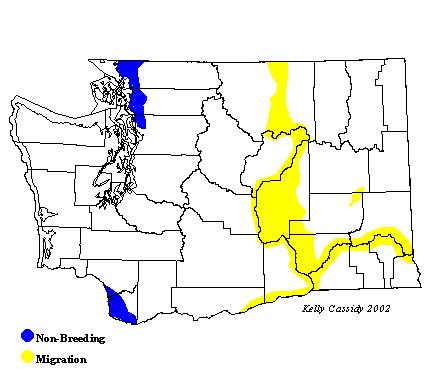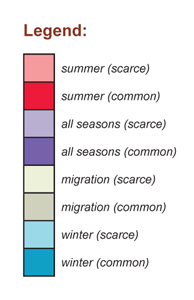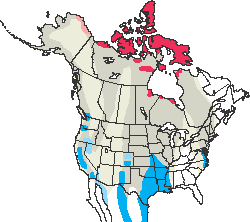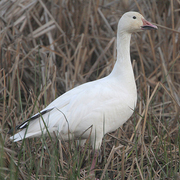Snow Goose
General Description
A large goose, the Snow Goose occurs in a white or a dark morph. The white morph, the most common, is all white with black primaries. The dark morph, known as the Blue Goose, is extremely rare in Washington and has a dark gray body and white head. Both morphs have orange legs. Juveniles are gray overall with dark legs. The Snow Goose is similar in appearance to the smaller and far less common Ross' Goose, but the Snow Goose has a 'grin-patch' (a dark patch on the side of the beak that makes it appear to be open or grinning) that the Ross' Goose lacks. There are two subspecies of Snow Goose, the Greater and the Lesser Snow Geese, which vary in size.
Habitat
Snow Geese nest colonially in the Arctic tundra within five miles of the coast. Greater Snow Geese tend to nest in higher, drier areas than Lesser Snow Geese. During migration and in winter, they inhabit coastal and freshwater marshes, estuaries, and agricultural lands, with Greater Snow Geese more likely to be in saltwater habitats than Lessers.
Behavior
Flocks are especially large in winter and during migration. Snow Geese forage mostly by walking in shallow water or on land, usually in flocks that may include other geese. They rip vegetation from the ground and can cause damage to areas where there are large numbers of geese.
Diet
Snow Geese feed almost exclusively on plant material. During the breeding season, they eat many seeds, leaves, and roots of aquatic vegetation. The very young birds feed on invertebrates. Berries become more important in the fall. In winter, waste grain from agricultural fields has become a primary food source.
Nesting
Long-term pair bonds are usually formed in the second year, although breeding doesn't usually start until the third year. Females are strongly philopatric, meaning they will return to the place they hatched to breed. Snow Geese often nest in colonies. The female selects a nest site and builds the nest on an area of high ground. The nest is a shallow depression lined with plant material and may be reused from year to year. After the female lays the first of 3 to 5 eggs, she lines the nest with down. The female incubates for 22 to 25 days, and the young leave the nest within a few hours of hatching. Both parents tend the young, but they feed themselves. After 42 to 50 days they can fly, but they remain with their family until they are 2 to 3 years old.
Migration Status
Large flocks migrate long distances, flying very high along narrow corridors and stopping at traditional stopover and wintering areas. Washington's population nests on Wrangel Island in Russia, north and west of the Bering Strait.
Conservation Status
The population was reduced to 2,000 to 3,000 birds in 1900, but has made a strong recovery since then. Many populations have increased to the point that they are causing management concerns. The Snow Goose is now one of the most abundant species of waterfowl in the world, with a population between 6 and 7 million. This recovery can be attributed to their ability to take advantage of previously unexploited food sources on migration and wintering grounds. Because of their practice of tearing vegetation out of the ground, they are destroying their own habitat in some areas. Snow Geese are widely hunted (from October to January in Washington), but more control measures may need to be taken in the future as the population continues to grow beyond an environmentally sustainable number.
When and Where to Find in Washington
Snow Geese are typically seen in large flocks; up to 55,000 winter in western Washington. Most gather in the Skagit River Delta (Skagit County) from mid-October to early May. They can also be seen in eastern Washington during migration (mid-April to mid-May and mid-October to mid-November).
 Abundance
Abundance
| Ecoregion | Jan | Feb | Mar | Apr | May | Jun | Jul | Aug | Sep | Oct | Nov | Dec |
|---|---|---|---|---|---|---|---|---|---|---|---|---|
| Oceanic | ||||||||||||
| Pacific Northwest Coast | R | R | R | R | R | R | R | |||||
| Puget Trough | C | C | C | C | U | R | C | C | C | |||
| North Cascades | ||||||||||||
| West Cascades | R | R | R | R | R | |||||||
| East Cascades | R | R | R | R | R | R | R | R | R | |||
| Okanogan | R | R | R | R | R | R | ||||||
| Canadian Rockies | R | R | R | R | ||||||||
| Blue Mountains | ||||||||||||
| Columbia Plateau | F | F | F | U | U | F | F |
Washington Range Map

North American Range Map


Family Members
 Fulvous Whistling-DuckDendrocygna bicolor
Fulvous Whistling-DuckDendrocygna bicolor Taiga Bean-GooseAnser fabalis
Taiga Bean-GooseAnser fabalis Greater White-fronted GooseAnser albifrons
Greater White-fronted GooseAnser albifrons Emperor GooseChen canagica
Emperor GooseChen canagica Snow GooseChen caerulescens
Snow GooseChen caerulescens Ross's GooseChen rossii
Ross's GooseChen rossii BrantBranta bernicla
BrantBranta bernicla Cackling GooseBranta hutchinsii
Cackling GooseBranta hutchinsii Canada GooseBranta canadensis
Canada GooseBranta canadensis Mute SwanCygnus olor
Mute SwanCygnus olor Trumpeter SwanCygnus buccinator
Trumpeter SwanCygnus buccinator Tundra SwanCygnus columbianus
Tundra SwanCygnus columbianus Wood DuckAix sponsa
Wood DuckAix sponsa GadwallAnas strepera
GadwallAnas strepera Falcated DuckAnas falcata
Falcated DuckAnas falcata Eurasian WigeonAnas penelope
Eurasian WigeonAnas penelope American WigeonAnas americana
American WigeonAnas americana American Black DuckAnas rubripes
American Black DuckAnas rubripes MallardAnas platyrhynchos
MallardAnas platyrhynchos Blue-winged TealAnas discors
Blue-winged TealAnas discors Cinnamon TealAnas cyanoptera
Cinnamon TealAnas cyanoptera Northern ShovelerAnas clypeata
Northern ShovelerAnas clypeata Northern PintailAnas acuta
Northern PintailAnas acuta GarganeyAnas querquedula
GarganeyAnas querquedula Baikal TealAnas formosa
Baikal TealAnas formosa Green-winged TealAnas crecca
Green-winged TealAnas crecca CanvasbackAythya valisineria
CanvasbackAythya valisineria RedheadAythya americana
RedheadAythya americana Ring-necked DuckAythya collaris
Ring-necked DuckAythya collaris Tufted DuckAythya fuligula
Tufted DuckAythya fuligula Greater ScaupAythya marila
Greater ScaupAythya marila Lesser ScaupAythya affinis
Lesser ScaupAythya affinis Steller's EiderPolysticta stelleri
Steller's EiderPolysticta stelleri King EiderSomateria spectabilis
King EiderSomateria spectabilis Common EiderSomateria mollissima
Common EiderSomateria mollissima Harlequin DuckHistrionicus histrionicus
Harlequin DuckHistrionicus histrionicus Surf ScoterMelanitta perspicillata
Surf ScoterMelanitta perspicillata White-winged ScoterMelanitta fusca
White-winged ScoterMelanitta fusca Black ScoterMelanitta nigra
Black ScoterMelanitta nigra Long-tailed DuckClangula hyemalis
Long-tailed DuckClangula hyemalis BuffleheadBucephala albeola
BuffleheadBucephala albeola Common GoldeneyeBucephala clangula
Common GoldeneyeBucephala clangula Barrow's GoldeneyeBucephala islandica
Barrow's GoldeneyeBucephala islandica SmewMergellus albellus
SmewMergellus albellus Hooded MerganserLophodytes cucullatus
Hooded MerganserLophodytes cucullatus Common MerganserMergus merganser
Common MerganserMergus merganser Red-breasted MerganserMergus serrator
Red-breasted MerganserMergus serrator Ruddy DuckOxyura jamaicensis
Ruddy DuckOxyura jamaicensis

